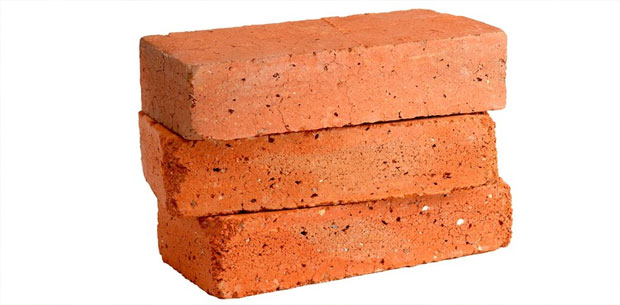
Bricks are the small rectangular blocks typically made of fired or sun-dried clay, typically used in building. The bricks are obtained by moulding clay in rectangular blocks of uniform size and then by drying and burning these blocks. As bricks are of uniform size, they can be properly arranged and further, as they are light in weight, no lifting appliance is required to them. The bricks don’t require dressing and the art of laying bricks is so simple that the brickwork can be carried out with the help of unskilled labours. Thus, at places where stones are not easily available, but if plenty of clay suitable for the manufacturing of bricks, the bricks replace stones.
The common brick is one of the oldest building materials and it is extensively used at present as a leading material of construction because of its durability, strength, reliability, low cost, easy availability, etc.
Contents:
History of Bricks
The bricks seem to have been produced since the dawn of the civilization in the sun-dried form. The Great Wall of China (210 B.C.) was built with both, burnt and sun-dried bricks. The other examples of the use of bricks in early stage of civilization could be cited in Rome and other places.
The medieval cities were of wood and because of the disastrous fire potential of wood; the bricks replaced the wood over the years. For instance, the great fire of London in 1666 changed London from being a city of wood to one of brick. A number of country farm houses still exists in Great Britain and profess to be monuments of the excellent hand-made bricks.
The bricks have been used all over the world in every class and kind of building. If the total bricks produced till today are to be counted, the figure would indeed be astronomical. It is understood that about 65 percent of the bricks in world goes into dwellings and the balance into commercial, industrial and institutional buildings.
The bricks have established as an age old material right from the thatched house to the multi-storeyed buildings. They were initially handmade and used as load bearing material for various structures. With the passage of time and advent of cement and steel, the frames only are filled up with the burnt clay bricks. The production of burnt clay bricks on a scientific and modern basis including proper mining of clays can lead to availability of quality bricks.
In India, the process of brick making has not changed since many centuries except some minor refinements. There have been hardly any efforts in the country to improve the brick-making process for enhancing the quality of bricks. The main reason for this attitude is that the production of bricks has been largely remained confined to the unorganized small sector. Some of the large mechanized brick plants came up in the past but they failed for some reason or other. The result is that the construction industry is largely dependent on the small sector which is unable to deliver high quality bricks in view of rising fuel cost, outdated technology and lower efficiency of production.
Brickwork vs Stonework
The brickwork is superior to the stonework in the following respects.
- At places where stones are not easily available but where there is plenty of clay, the brickwork becomes cheaper than stonework.
- The cost of construction works out to be less in case of brickwork than stonework as less skilled labour is required in the construction of brickwork.
- No complicated lifting devices are necessary to carry bricks as they can be easily moved by manual labour.
- The bricks resist fire better than stone and hence, in case of a fire, they don’t easily disintegrate.
- The bricks of good quality resist the various atmospheric effects in a better way than the stones.
- In case of brickwork, the mortar joints are thin and hence the structure becomes more durable.
- It is easy to construct connections and openings in case of brickwork than stonework.
The brickwork is inferior to the stonework in the following respects:
- The brickwork is less watertight than stonework. The bricks absorb moisture from the atmosphere and dampness can enter the building.
- The brickwork doesn’t create a solid appearance in relation to the stonework and hence, for public buildings and monumental structures, the stonework is found to be more useful than brickwork.
- The stonework is stronger than brickwork.
- The architectural effects of better quality can be developed by the stonework.
- The stonework is cheaper at places where stones are easily available.
Composition of good brick material
Following are the constituents of good brick material:
- Alumina: It is the chief constituent of every kind of clay. A good brick should contain 20% to 30% of alumina. This constituent imparts plasticity to the clay so that it can be moulded. If alumina is present in excess, with inadequate quantity of sand, the raw bricks shrink and warp during drying /burning and become too hard when burnt.
- Silica: It exists in clay either as free or combined. As free sand, it is mechanically mixed with clay. In combine form, it exists in chemical composition with alumina. A good brick material should contain about 50% to 60% of silica. The presence of this constituent prevents cracking, shrinking and warping of raw bricks. It thus imparts uniform shape to the bricks. The durability of bricks depends on the proper proportion of silica in brick material. The excess of silica destroys the cohesion between particles and the bricks become brittle.
- Lime: A small quantity of lime not exceeding 5 percent is desirable in good brick material. It should be present in a very finely powdered state because even small particles of the size of a pin-head cause flaking of the bricks. The lime prevents shrinkage of raw bricks. The sand alone is infusible. But it slightly fuses at kiln temperature in presence of lime. Such fused sand works as a hard cementing material for brick particles. The excess of lime causes the brick to melt and hence its shape is lost. The lumps of lime are converted into quick lime after burning and this quick lime slakes and expands in presence of moisture. Such an action results in splitting of bricks into pieces.
- Oxide of iron: A small quantity of oxide of iron to the extent of about 5 to 6 percent is desirable in good brick material. It helps as lime to fuse sand. It also imparts red colour to the bricks. The excess of oxide of iron makes the bricks dark blue or blackish. If, on the other hand, the quantity of iron oxide is comparatively less, the bricks will be yellowish in colour.
- Magnesia: A small quantity of magnesia in brick material imparts yellow tint to the bricks and decreases shrinkage. However, excess of magnesia leads to the decay of bricks.
Harmful ingredients in brick material
Following are the ingredients which are undesirable in the brick material:
- Lime: The excess of lime is undesirable in brick material.
- Iron pyrites: If iron pyrites are present in brick material, the bricks are crystallized and disintegrated during burning because of the oxidation of the iron pyrites.
- Alkalies: These are mainly in the form of soda and potash. The alkalies act as a flux in the kiln during burning and they cause bricks to fuse, twist and warp. As a result, the bricks are melted and they loose their shape. Further, the alkalies remaining in bricks will absorb moisture from the atmosphere, when bricks are used in masonry. Such moisture, when evaporated, leaves behind grey or white deposits on the wall surface. The appearance of the building as a whole is then seriously spoiled.
- Pebbles: The presence of pebbles or grits of any kind is undesirable in brick material because it will not allow the clay to be mixed uniformly and thoroughly which will result in weak and porous bricks. Also, the brick containing pebbles will not break regularly as desired.
- Vegetation and organic matter: The presence of vegetation and organic matter in brick material assists in burning. But if such matter is not completely burnt, the bricks become porous. This is due to the fact that the gases will be evolved during the burning of the carbonaceous matter and it will result in the formation of small pores. Hence, it is necessary to see that all these gases are removed during the process of burning for getting bricks of good quality.
Qualities of good bricks
The good bricks which are to be used for the construction of important structures should posses the following qualities:
- The bricks should be table-mounted, well burnt in kilns, copper-coloured, free from cracks and with sharp & square edges. The colour should be uniform and bright.
- The bricks should be uniform in shape and should be of standard size.
- The bricks should give a clear metallic ringing sound when struck with each other.
- The bricks when broken or fractured should show a bright homogeneous and uniform compact structure free from voids.
- The bricks shouldn’t absorb water more than 20 percent by weight for first class bricks and 22 percent by weight for second class bricks, when soaked in cold water for a period of 24 hours.
- The bricks should be sufficiently hard. No impression should be left on brick surface, when it is scratched with finger nail.
- The bricks should not break into pieces when dropped flat on hard ground from a height of about one meter.
- The bricks should have low thermal conductivity and they should be sound-proof.
- The bricks, when soaked in water for 24 hours, should not show deposits of white salts when allowed to dry in shade.
- No brick should have the crushing strength below 5.5 N/mm2.
Strength of bricks
Following factors affect the strength of bricks:
- Composition brick making material
- Preparation of clay and blending of ingredients
- Nature of moulding adopted
- Care taken in drying and stacking of raw or green bricks
- Type of kiln used including type of fuel and its feeding
- Burning and cooling processes
- Care taken in unloading
It is thus obvious that not only the bricks of different brick fields will have different strengths, but in the same brick field, the bricks of the same batch may have different strengths.
The average crushing strength and tensile strength of hand moulded bricks are 60,000 kN/m2 and 2000 kN/m2 respectively. The shearing strength of bricks is about one-tenth of the crushing strength. In practice, however, the bricks are not subjected to the tensile stresses.
It may be noted that the strength of brickwork mainly depends on the type of mortar used and not so much on the individual strength of the bricks.

